If you enjoyed this edition of Voices - please forward to others who may be interested. | |
|
|
|
|
|
|
OF A Navy VETERAN
Sep 2017
|
|
|
|
|
|
Ficalora, Anthony PhoM1c
|
|
| Status |
Service Years |
|
|
|
USN Veteran
|
1942 - 1946
|
|
|
| NEC |
|
|
PhoM-0000-Photographer's Mate
|
|
|
| Primary Unit |
|
|
1945-1946, PhoM-0000, USS Curtiss (AV-4)
|
|
|
|
|
|
|
|
Record Your own Service Memories
By Completing Your Reflections!
|
|
|
Service Reflections is an easy-to-complete self-interview, located on your TWS Profile Page, which enables you to remember key people and events from your military service and the impact they made on your life.
|
|
|
|

|
|
|
|
|
| |
|
Please describe who or what influenced your decision to join the Navy?
|
| |
 |
| Anthony Ficalora Navy Boy |
As a young boy, my mother dressed me in a Navy outfit. As I grew older, my thoughts were that someday, I would like to be in the Navy. In 1942, the World War was raging in Europe and the Japanese were attacking us in the Pacific. The government Selective Service Agency was active in drafting men for the Army.
It was a matter of time before I would receive a notice to report to the Army Recruiting Office. I knew my preference was the Navy. I reviewed this with my father, who always gave me very good advice. My dad agreed. It was the Navy for me.
On October 29, 1942, at the age of 20 years, I volunteered and joined the United States Navy.
I am proud to have served in the US Navy.
|
| |
|
Whether you were in the service for several years or as a career, please describe the direction or path you took. What was your reason for leaving?
|
| |
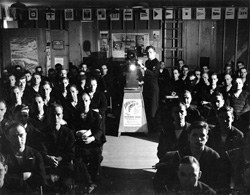 |
| AVA School Training Presentation |
My career path was one of being a member of the Newport Naval Training's Ships Companie's Audio Visual Aids Department.
The other, being assigned to the USS Curtiss, a Sea Plane Tender and Flag Ship.
December 1942
Audio Visual Aids Training Dept. As a photographer's mate, I had extraordinary learning and challenging experiences. Photographing at the many instructional training schools, shooting public relations photos, portraits of officers, photographing subjects for the news of the day, for the Drill Hall presentations, a staff Photographer for the Newport Navalog, the base's news publication, plus photographing many informational subjects.
March of 1945
USS Curtiss AV4
March 27, 1945, I received orders for sea duty. Leaving Newport R. I. to San Diego, Ca. Railroaded from Newport to Providence, to New York, to Chicago, and to Los Angeles,
April 6, 1945
Arrived in San Diego, where I reported to Utility Squadron Nine and put on a list for sea duty. In one week I was assigned to the USS Curtiss.
 April 13, 1945 April 13, 1945
In Alameda, I boarded the USS Curtiss AV4, a Seaplane Tender and Flag Ship. The Curtiss was preparing for sea duty, taking on supplies and military cargo.
On April 20, 1945, We shipped out to the Pacific.
From Alameda, California, stopping at Hilo Hawaii, Pearl Harbor, Honolulu, Tinian, Saipan. The crew was assigned Battle Stations and issued helmets. My battle station was with our Executive Officer, Lt. Commander Coughlin and a Signal Man. We had General Quarters and gunnery practices. A plane flying from Saipan with a trailing target, gave us firing practice for our gunners, manning the 40-millimeter battle stations,
May 22, 1945
We arrived at Kerama Retto, 15 miles from Okinawa, where the war action was severe. We had 66 General Quarters Alarms, alerting the ship's crew of Japanese air raid attacks.
Our signalman kept us informed on how close the bogies (Japanese Planes) were to our ship. Our Smoke boats in surrounding our ship, proceeded in making smoke, covering us as a camouflage. making it difficult for the Japanese planes locating our position. At dusk and through the night we would have three or four air raids attacks a night. Many times all through the night.
Took many service photographs aboard ship. I was assigned to shoot pictures at a Destroyer Grave Yard, off of Okinawa, where many of our Navy Destroyers were severely attacked. The amount of battle destruction was unbelievable and frightening, thinking about our brave men aboard these ships.
On June 21, 1945, the Curtiss was attacked by a Kamikaze plane, killing many men and severely damaging our ship.
We headed back to the Mare Island Navy Yard, in Vallejo, California, for reconstruction.
Chow aboard the Curtiss, was the best. At breakfast, every Sunday morning, we would have eggs sunny side up and trimmings. On our return back to Alameda, due to our ship being overloaded with eggs. we had eggs sunny-side up, every day.
 On August 14, 1945, the surrender of Imperial Japan, was announced. I was in San Francisco on Market Street, celebrating, there were church bells ringing, car horns beeping, sirens going off. Everyone was hilarious, kissing each other, dancing and whooping it up. On August 14, 1945, the surrender of Imperial Japan, was announced. I was in San Francisco on Market Street, celebrating, there were church bells ringing, car horns beeping, sirens going off. Everyone was hilarious, kissing each other, dancing and whooping it up.
At the Pepsi-Cola Servicemen Center, Sailors climbed up the statue's pole, waving American flags. The greatest of time.
November 6, 1945, with the ships complete reconstruction, the Curtiss shipped out to Sea again, stopping at Pearl Harbor, Chimu Wan, Okinawa, Shanghai, China, Tokyo, Japan, Yokohama, Japan.
December 1945
In Tokyo Bay, Lt. Commander Coughlin, Executive Officer, informed me, he received orders for my discharge. Lt. Commander Coughlin gave me two options, to stay in the Navy, with a promotion to Warrant Officer or to going home.
When I heard the word home, that rang a bell, I elected to go home.
I was most anxious to get my career started again, as an advertising photographer, in New York City's advertising world.
I thanked Lt. Commander Coughlin profusely.
|
| |
|
If you participated in any military operations, including combat, humanitarian and peacekeeping operations, please describe those which were the most significant to you and, if life-changing, in what way.
|
| |
 |
| USS Curtiss after attack in Guam removing Crane |
The most significant operations occurred at dusk, on June 21, 1945. The seaplane tender USS CURTISS' fighting power survived at almost maximum strength the crash of a Japanese suicide plane and its 1,000-pound bomb, although 35 men were killed and 21 wounded. To my deepest regret, Harry B. Foard, George V. Nolan Jr. and Maurice A. Nygaard, my fellow members of the Photo Lab, were killed.
The Kamikaze's delayed action bomb rammed through to the centerline of the Curtiss before exploding immediately over a bomb storage magazine which miraculously escaped detonation.
The Curtiss was operating in the Southern Ryukus Islands near Okinawa when the Kamikaze struck at dusk. The Japanese took advantage of the gathering darkness and concealment of neighboring island to approach within 800 yards before he was sighted by lookouts aboard the Curtiss. The plane struck on the starboard side amidships at an estimated speed of 400 knots. The engine, part of the tail assembly and the heavy bomb ripped through the skin of the ship, opening two gaping holes and exploding on the third deck. The terrific explosion wiped out the sick bay spaces, together with the Warrant Officer's mess-room, staterooms, Officer's galley, library, photo lab, barber shop and Post Office.
Choking smoke gushed from the damaged area and flames licked through four decks above the point of the explosion. Fire mains and sprinkler systems in the blasted area were ruptured and the fire-fighting crew brought emergency extinguishing equipment to bear.
At this critical stage, however, the main propulsion engines were operative and the Curtiss should have proceeded at moderate speed. Also, gun crews standing at General Quarters stations against further air attack found all guns operative except the forward five-inch battery.
_burning_7_Dec_1941.jpg) With the fires out of control, there was imminent danger of the flames reaching the bomb stowage magazines. During this critical period, many acts of individual heroism were observed. With the fires out of control, there was imminent danger of the flames reaching the bomb stowage magazines. During this critical period, many acts of individual heroism were observed.
When it became apparent that a great volume of water was needed to control fires in the Curtiss, two salvage vessels and two ocean tugs came alongside to assist.
These small ships, under grave danger for a threatened explosion of the Curtiss' magazine, remained alongside for more than an hour pumping heavy streams of water into the burning compartments. The SHAKLE sent a combat fire team aboard the Curtiss to cut their way with torches into a compartment in which a dangerous fire was burning.
With the flames under control, the ship's force turned to, with little rest, to clear away the debris and pump out flooded magazines and compartments. Then a service force repair crew came aboard to weld a boilerplate on the five by an eight-foot gash in the hull. The ship was prepared to proceed.
The Commanding Officer credited the cool efficiency of the entire ship's company, in the face of great danger, with saving the ship and reducing casualties to a minimum.
Our crew was very thankful for the support we received from the brave Navy Firemen, and to ships and men, who came to our rescue.
This indeed was a most significant experience.
|
| |
|
Was there a particular incident during your service when you believed you were in a situation you might not survive? Please describe what happened and what was the outcome.
|
| |
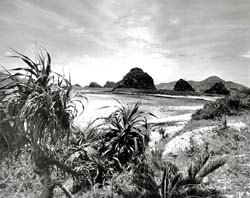 |
| Kamikaze attack at Chimu Wan, Okinawa |
A kamikaze plane crashed through the ship's photo lab piercing through other compartments and exploding. I was at the aft part of the ship when I heard a thunder and a big hiss and loud puff of air coming aft. Immediately, General Quarters alarm went off, requiring all men, on the double, to their battle stations. It was miraculous, the USS Curtiss didn't explode, killing all aboard. I count my blessings to survive this attack. The Navy firemen, ships, and men who came to our rescue were in great danger, fighting the raging fires, saved us and our ship.
|
| |
|
Of all your duty stations or assignments, which one do you have fondest memories of and why? Which one was your least favorite?
|
| |
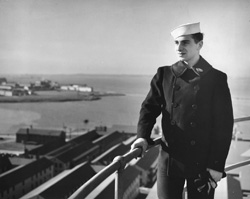 |
| High on the Water Tower photographing Newport's0 Officer's Living Quarters & Navy Barracks |
I have the fondest memories of the many exciting events, I photographed.
My duty station in Audio Visual Aids, as a photographer's mate, was very rewarding. I was very active in photographing the many activities at the training station, such as the many instruction classes, war news presentations various activities at the Drill Hall, photographing the Duke and Duchess of Windsor with Captain Mcgruder at the Drill Field. Climbing up the water tower to photograph the entire drill field. Also, as a staff Navalog photographer, photographing the Stations activities for The NEWPORT NAVALOG publication.
Climbing up the water tower was most memorable. Climbing with my camera bag around my shoulders, taking one step at a time going up. When I got to the top, there was another ladder going straight up to the platform, which was around the water tower. As I was climbing up this ladder I felt like I was climbing up and out, and no less the wind was blowing harder at the upper elevations. It was very scary. I got to the platform and took my pictures. Climbing down, was even scarier. I was praying holding tightly to each rung, I was afraid of misstepping because I couldn't look down. Slow and steady did it.
 I was then asked to photograph, the Officer's Quarter's and the Seamen's Barracks at the Newport Naval Station, from the Water Tower. This time I went up the water tower with my friend, Don Camparone, for security reasons and to confirm, with my friend, the experiences I had the first time I was up to the Water Tower. I was then asked to photograph, the Officer's Quarter's and the Seamen's Barracks at the Newport Naval Station, from the Water Tower. This time I went up the water tower with my friend, Don Camparone, for security reasons and to confirm, with my friend, the experiences I had the first time I was up to the Water Tower.
Don was amazed when we got up to the top. I photographed Don on top and he photographed me on top.
After photographing the Station, we climbed down slowly. He and I were relieved when we touched the ground.
Don kissed the ground. I couldn't be happier, getting down to solid earth.
The least favorable occurred on June 21, 1945, when our ship was attacked by a Japanese Kamikaze plane. From dusk to the next day the ship was under General Quarters, with all men at their battle stations. Firefighters fighting fires and the danger of another plane attack.
|
| |
|
From your entire service, including combat, describe the personal memories which have impacted you most?
|
| |
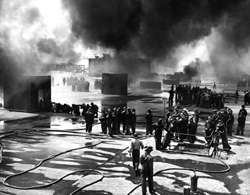 |
| Brave Firemen & Ships Saved the Curtiss, Firefighters Training School |
On our way to Pearl Harbor, there was scuttlebutt the USS Curtiss was heading to Okinawa, where the action was hot. Some men who had enough actions, put in requests for transfer, to our Executive Officer.
Lt. Commander Coughlin announced, through the ship's loudspeaker system, for all men to assemble in the ships, seaplane Hanger. All assembled information, he lectured us, in the sternest and in the strongest demeanor,
"You're here to fight a war, I don't want any of my men to lack the intestinal fortitude in facing the enemy. You're fighting for your country! You must have the backbone, to face the enemy head on. There shall be No Yellows Bellies on this ship".
"All Requests For Transfer, DENIED!"
This was and is memorable.
|
| |
|
What achievement(s) are you most proud of from your military career?
|
| |
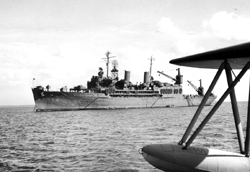 |
| 12/9/1945 USS CURTISS in Chimu Wan, Okinawa at Anchorage |
Lt. Paul A. Wagner, head of Audio Visual Aids, ran each department with pride, demanding men to perform intelligently and efficiently. A well-respected leader. Audio Visual Aids Department was a significant member of the Newport Naval Training Station.
I was very pleased in achieving progressive ratings, from Apprentice Seaman to Photographer's Mate 3rd class to Photographer's Mate 2nd Class to Photographer's Mate 1st class. I also progressed in being in charge of Audio Visual Aids, Photographic Department. I was very proud to have achieved my growth through diligent and outstanding work.
I am also proud of being 'Commended as a member of the crew of the USS Curtiss by the Commanding Officer, for being a most loyal and courageous crew, and for outstanding conduct and bravery on the night of June 21, 1945'.
By Lt. Commander J.W. Coughlin, Executive Officer.
|
| |
|
Of all the medals, awards, formal presentations and qualification badges you received, or any other memorabilia, please describe those which are the most meaningful to you and why?
|
| |
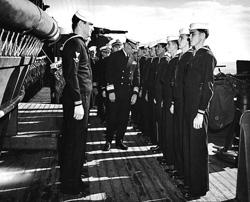 |
| 12/15/45 Admiral's Perry's Inspection at East China Sea |
The following is my most meaningful acknowledgment, by our Executive Officer:
Participated in the RYUKYU ISLANDS, Campaign in the Kerama Retto Group, East China Sea, during the campaign for Okinawa, and after that island was secured, from 22 May 1945, onboard the USS Curtiss (AV4), and proper entry should be made in service record when authority is received from BuPers awarding the campaign medal for that area.
J. W. Coughlin
By Direction
|
| |
|
Which individual(s) from your time in the military stand out as having the most positive impact on you and why?
|
| |
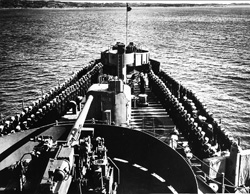 |
| 12/15/45 USS CURTISS Admiral Perry's Inspection in East China Sea |
Lt. Commander J. W. Coughlin, Executive Officer, aboard the USS Curtiss, stands out. He ran our ship, efficiently and effectively. He supplied daily bulletins, Plan of the Day, directing the activities of the ship, reporting news, war bulletins and other important Navy information.
He encourages his men for advancement. Looked out for the crews best interests.
Our ship was battle ready. We went through a series of gunnery exercises and exercises in protecting our men and ship. A great leader and disciplinarian.
My battle station, at the ships secondary controls, on top deck, mid ship, was with
Lt. Commander Coughlin.
Should the Bridge of our ship be destroyed, the Executive officer takes command, at the ships secondary controls. He was highly qualified.
I am proud to have served alongside Lt. Commander J. W. Coughlin.
|
| |
|
Please recount the names of friends you served with, at which location, and what you remember most about them. Indicate those you are already in touch with and those you would like to make contact with.
|
| |
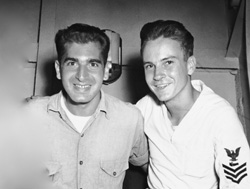 |
| My Friend Leo Schad, from Audio Visual Aids & on the Battle Ship, USS New Jersey, in Pearl Harbor |
On June 15, 1945, in the USS Curtiss, in Kerama Retto, Okinawa, I received a message from the signal bridge, my friend, Don Camparone, who I served with at Audio Visual Aids in Newport, was here in the harbor on an Oil Tanker. The next day Don came to our ship. We were very happy to see each other. At the visit, he told me he had been very lucky. He had won over four hundred dollars and wanted me to mail it to his mother. The Curtiss had a US Post Office aboard ship. The next day I mailed the funds to his mother. Shortly thereafter, Don informed me his ship had orders to move out.
Seeing Don in Okinawa was an unexpected, memorable one.
On June 21st, the Curtiss was hit by a Japanese kamikaze plane. On our way back to the US, stopping at Pearl Harbor on July 26th, I met another mate, Leo Schad, Photographer's Mate, First Class, aboard the battleship, USS NEW JERSEY.
I spent some time with Leo in the Photography Department at Audio Visual Aids, in Newport, R.I. We did a lot of Photographic work at AVA, enjoyed the camaraderie of the Photography Department.
This was another unexpected and a very pleasant meeting, aboard the big USS New Jersey, recollecting our experiences at AVA and interesting fun times.
|
| |
|
Can you recount a particular incident from your service which may or may not have been funny at the time, but still makes you laugh?
|
| |
 |
| My Best Friend, Don Camparone from Audio Visual Aids, Kerama Retto, Okinawa & in San Francisco on Ma |
The USS Curtiss was at the Mare Island Navy Yard. I was in San Francisco on a Sunday morning, walking down to the Pepsi Service Men Center, on Market Street, to inquire the location of my friend Don's ship,
Walking down a high hill from Geary Street to Market Street, I see at a long distance, someone walking up the hill. As we got closer and closer, to our surprise it was my friend Don. We embraced, smiling and laughing at how it was possible for us to meet unexpectedly, at the exact time.
We celebrated being together, again. Talking about our AVA and Sea Duty experiences.
We never stop talking and laughing about the perfect timing, for us to come together at the same time, in San Francisco.
This was unbelievable and unforgettable.
|
| |
|
What profession did you follow after your military service and what are you doing now?
|
| |
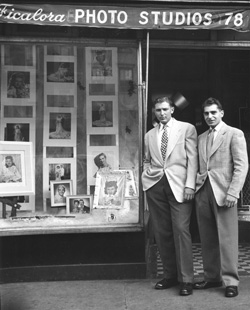 |
| Ficalora Photo Studio Sal & Anthony |
After the service, I relocated, as an assistant photographer, to the Studio I was with before serving. After two years, I went on my own. In March of 1948, I started my studio at 78 Second Avenue, New York City. My father had a Portrait Studio in the same building.
Getting off the ground, I was lucky to land an account at Bloomingdales Department Store. I progressed to having accounts at the major advertising agencies. Then I became a consultant for a TV commercial production company. Embellishing the look, the lighting and color coordination of the TV commercials. After several consulting Commercials, I realized it would be beneficial for me to become knowledgeable in the many segments of shooting and producing a film commercial.
I attended several classes at the School of Visual Arts on the Production and Budgeting of TV commercials. Became knowledgeable in Editing and Sound and effects.
After doing some testing with a motion picture camera, with my son, Paul, my brother Sal was able to bring in a test commercial from two young Art Directors at Young & Rubicum. This proved to be very successful. This was well received with the New York Advertising Agencies. That was the beginning of my career in Producing, Shooting, Editing, Color corrections of Optical to completion of a TV Commercial.
I was a pioneer in the transition of a still photographer to Directing and Producing TV Commercials. Winning many National and International awards.
1948 to 1968 Advertising photography for the major national Advertising Agencies.
1968 to 1987 Producer, Director, Cameraman of TV Commercials.
I retired in August of.1987. Very active in personal interests.
|
| |
|
What military associations are you a member of, if any? What specific benefits do you derive from your memberships?
|
| |
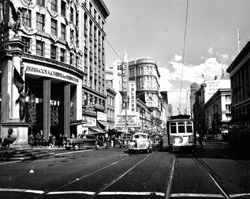 |
| Pepsi Cola Servivemens Center on Market St. San Francisco |
I have not been active in military memberships.
I've been active with TWS, reliving my Navy experiences.
|
| |
|
In what ways has serving in the military influenced the way you have approached your life and your career?
|
| |
 |
| US Navy on Parade |
My Navy experience was a major asset in human relations, in being organized and disciplined.
The Navy contributed in rounding out my personal and professional experiences.
Became knowledgeable in many areas of photography. Knowledgeable in close-up photography, action photography, interior, exterior photography, to shooting Arial photography.
The Navy was a priceless experience.
|
| |
|
Based on your own experiences, what advice would you give to those who have recently joined the Navy?
|
| |
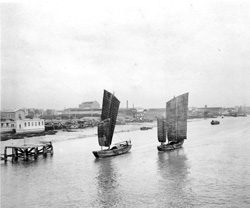 |
| 12/19/1945 Chinese Junks, Hwangpoo River, Shanghai, China |
Grow and persevere, in climbing the ladder of experience. Don't give up.
The human relationship is very important, getting along with everyone, is the way to go. It is wonderful being on a ship, traveling to interesting and unexpected parts of the world.
Navy is a life of enriching experiences.
|
| |
|
In what ways has TogetherWeServed.com helped you remember your military service and the friends you served with.
|
| |
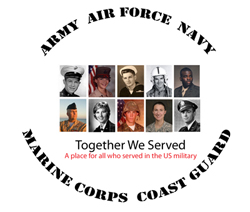 |
| TWS and the US Navy |
TWS has rekindled a number of great experiences in my Navy career. I am reliving my Navy life, all over again.
Life experiences in the Navy will always be cherished, thanks to NAVY TOGETHER WE SERVED.
|
| |
| |
|
|
|
| |
Get Started On Together We Served
Watch our video and see what TWS is all about
|
| |
|

|
| |
|
|
|
|
|
|